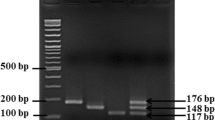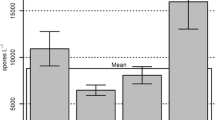Abstract
Late blowing, a microbiological spoilage in hard and semi-hard cheese caused by Clostridium spores in raw milk, results in high economic losses for cheese producers. This study compared the sensitivity of the newly developed multiplex qPCR method which employing novel oligonucleotide primers and fluorescent TaqMan probes, and the culture-based most probable number (MPN) method in detecting the late blowing agent Clostridium species in traditional Turkish cheese. A total of 50 naturally contaminated cheese samples obtained from producers were analysed by both methods. Clostridium tyrobutyricum was the most common species occurring in 74% of the cheese samples, followed by C. butyricum and C. sporogenes occurring in 50% and 16% of the samples, respectively. The results of the two methods were consistent in 42 out of the 50 (84%) cheese samples. Our results indicate that the multiplex qPCR method is more sensitive than the MPN method. The multiplex qPCR method provided a favourable alternative to traditional cultural methods. This alternative molecular method has great potential in the laboratory and in the field for the rapid detection of late blowing of cheese samples.
Similar content being viewed by others
Data Availability
The datasets analysed during the current study are available from the corresponding author on reasonable request.
References
Avila M, Gomez-Torres N, Hernandez M, Garde S (2014) Inhibitory activity of reuterin, nisin, lysozyme and nitrite against vegetative cells and spores of dairy related Clostridium species. Int J Food Microbiol 172:70–75
Ávila M, Sánchez C, Calzada J, Mayer MJ, Berruga MI, López-Díaz TM, Narbad A, Garde S (2023) Isolation and characterization of new bacteriophages active against Clostridium tyrobutyricum and their role in preventing the late blowing defect of cheese. Food Res Int 163:112222. https://doi.org/10.1016/j.foodres.2022.112222
Beresford TP, Fitzsimons NA, Brennan NL, Cogan TM (2001) Recent advances in cheese microbiology. Int Dairy J 11:259–274
Brändle J, Domig KJ, Kneifel W (2016) Relevance and analysis of butyric acid producing clostridia in milk and cheese. Food Control 67:96–113. https://doi.org/10.1016/j.foodcont.2016.02.038
Brändle J, Fraberger V, Berta J, Puglisi E, Jami M, Kneifel W, Domig KJ (2018) Butyric acid producing clostridia in cheese—towards the completion of knowledge by means of an amalgamate of methodologies. Int Dairy J 86:86–95. https://doi.org/10.1016/j.idairyj.2018.07.008
Brasca M, Morandi S, Silvetti T (2020) Clostridium spp. In McSweeney PLH, McNamara J P (Eds.), Encyclopedia of Dairy Sciences Academic Press, pp 431–438
Cocolin L, Innocente N, Biasutti M, Comi G (2004) The late blowing in cheese: a new molecular approach based on PCR and DGGE to study the microbial ecology of the alteration process. Int J Food Microbiol 90:83–91. https://doi.org/10.1016/S0168-1605(03)00296-4
Cremonesi P, Vanoni L, Silvetti T, Morandi S, Brasca M (2012) Identification of Clostridium beijerinckii, Cl. butyricum, Cl. sporogenes, Cl. tyrobutyricum isolated from silage, raw milk and hard cheese by a multiplex PCR assay. J Dairy Res 79:318–323. https://doi.org/10.1017/S002202991200026X
Drouin P, Lafrenière C (2012) Milk production - an up-to-date overview of animal nutrition, management and health. In: Chaiyabutr N (ed) Clostridial spores in animal feeds and milk, intechopen. https://doi.org/10.5772/50775
Hayaloğlu AA (2017) Cheese varieties ripened under brine. In McSweeney PLH, Fox PF, Cotter PD, Everett DW (Eds.), Cheese, Academic Press, pp 997–1040. https://doi.org/10.1016/B978-0-12-417012-4.00039-9
ISO 16140-2 (2016) Microbiology of the food chain—method validation–Part 2: protocol for the validation of alternative (proprietary) methods against a reference method. International Organization for Standardization, Geneva, Switzerland
Mayer MJ, Payne J, Gasson MJ, Narbad A (2010) Genomic sequence and characterization of the virulent bacteriophage phiCTP1 from Clostridium tyrobutyricum and heterologous expression of its endolysin. Appl Environ Microbiol 76(16):5415–22. https://doi.org/10.1128/AEM.00989-10
Morandi S, Cremonesi P, Silvetti T, Castiglioni B, Brasca M (2015) Development of a triplex real-time PCR assay for the simultaneous detection of Clostridium beijerinckii, Clostridium sporogenes and Clostridium tyrobutyricum in milk. Anaerobe 34:44–49. https://doi.org/10.1016/j.anaerobe.2015.04.005
Quigley L, O’Sullivan O, Beresford TP, Ross RP, Fitzgerald GF, Cotter PD (2011) Molecular approaches to analysing the microbial composition of raw milk and raw milk cheese. Int J Food Microbiol 150:81–94
Şahiner A, Çalışkan S, Halat E (2022) Development of a new multiplex quantitative real-time polymerase chain reaction method for Clostridium butyricum, Clostridium sporogenes and Clostridium tyrobutyricum detection in cheese. LWT 155:112914. https://doi.org/10.1016/j.lwt.2021.112914
Sheehan JJ (2021) Cheese: avoidance of gas blowing, Encyclopedia of Dairy Sciences. Academic Press, San Diego, CA, pp 661–666
Volk H, Piskernik S, Kurinčič M, Klančnik A, Jeršek B (2014) Evaluation of different methods for DNA extraction from milk. J Food Nutr Res 53:97–104
Yerlikaya O, Akbulut N (2019) Potential use of probiotic Enterococcus faecium and Enterococcus durans strains in Izmir Tulum cheese as adjunct culture. J Food Sci Technol 56(4):2175–2185. https://doi.org/10.1007/s13197-019-03699-5
Acknowledgements
We are grateful to the Ege University Planning and Monitoring Coordination of Organizational Development and Directorate of Library and Documentation for their support in editing and proofreading service of this study.
Funding
This work was funded by the Scientific and Technological Research Council of Turkey (TUBITAK; Project No. 218Z113).
Author information
Authors and Affiliations
Contributions
All authors contributed to the study conception and design. All authors wrote the main manuscript text and prepared tables. All authors reviewed the manuscript.
Corresponding author
Ethics declarations
Conflict of Interest
Aslı Şahiner declares that she has no conflict of interest. Sennur Çalışkan declares that she has no conflict of interest. Ece Halat declares that she has no conflict of interest.
Additional information
Publisher's Note
Springer Nature remains neutral with regard to jurisdictional claims in published maps and institutional affiliations.
Rights and permissions
Springer Nature or its licensor (e.g. a society or other partner) holds exclusive rights to this article under a publishing agreement with the author(s) or other rightsholder(s); author self-archiving of the accepted manuscript version of this article is solely governed by the terms of such publishing agreement and applicable law.
About this article
Cite this article
Şahiner, A., Çalışkan, S. & Halat, E. Quantitative Detection of Late Blowing Agents C. tyrobutyricum, C. butyricum, and C. sporogenes in Traditional Turkish Cheese by Multiplex Real-Time PCR. Food Anal. Methods 16, 781–786 (2023). https://doi.org/10.1007/s12161-023-02454-z
Received:
Accepted:
Published:
Issue Date:
DOI: https://doi.org/10.1007/s12161-023-02454-z




